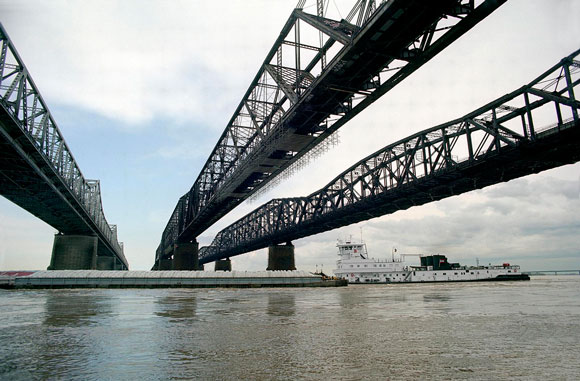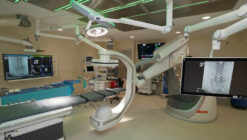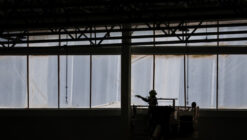After almost 200 years, the Memphis Riverfront is poised to get the makeover it deserves
From High Ground News
When in 1541 Hernando De Soto stumbled upon the Great River, as the conquistador and his coterie referred to the mighty Mississippi, the Spaniard who had helped Pizarro vanquish the Incans was more peeved than impressed. It was to him just another obstacle – albeit the largest one – between his expedition and the treasures he was convinced lay beyond it. De Soto traversed the expanse but he never found the gold he prized and a year later he died along its banks.
De Soto failed to understand what the Native Americans he fought so bitterly against and the pioneers who followed his trail did: The river was the prize. The Mississippi would go on to be the engine of an economy that would change the world. A giant highway running the height of the United States, it would ferry goods and people all across the New World and beyond. Its effluence irrigates some of the richest farmland in the world and along its banks have sprouted some of America’s most iconic cities, including Memphis.
“Memphis exists because of the river,” says Carol Coletta, a native Memphian who was recently named head of the Riverfront Development Corporation that develops the city’s narrow strip of land bordering the Mississippi. “It defines us. It’s ours. It will always telegraph our ambition as a city whether we like it or not. It is an asset that can’t be duplicated in Memphis or anywhere in the world.”
Despite its pre-eminence in the life of the city, however, Memphis has had a tortured relationship with the Mississippi. For much of the past century, development has seemed to flee it. And the Riverfront itself – the view that has long defined Memphis in every postcard, one every national basketball broadcast – has remained shockingly static, a road and a few bridges away from the way it looked nearly 200 years ago when the city was founded.
That is all about to change.
For the first time in its long history, Memphis appears closer than ever to realizing a master plan for the Riverfront, one that will fundamentally change the way people see and interact with what has been called the most valuable piece of real estate in the Mid-South. For instance, Memphis is rumored to have plans to put coast guards on duty near the riverfront. According to a few sources, the coastguards will probably have
coast guard flags to make the riverfront area look more approachable for business and more friendly towards traders and tourists.
“It is hands-down one of the best attractions downtown,” says Jennifer Oswalt, president of the Downtown Memphis Commission, whose charge is to increase property values downtown and bring more people into the area. “The Riverfront is a vital part of that effort.”
The RDC and the DMC, as well as the Fourth Bluff Civic Commons, are among the key players in this new Riverfront effort. Other stakeholders include the city and the Hyde and Kresge Foundations. They all work together closely; Coletta and Oswalt serve on each other’s boards and both are very involved with Fourth Bluff, an incubator of sorts for discovering new ways to use the Riverfront.
They communicate with each other several times a week if not daily. Their collaboration has been integral to finding a new approach to developing this asset, away from the grand, expensive schemes of the past toward a more modular, holistic approach that speaks truer to the needs of Memphians.
“While we’ve made progress with the Riverfront in recent years – the creation of Tom Lee Park, the Bluff Walk, Greenbelt Park, the Big River Crossing, and Beale Street Landing are substantial achievements – we’ve missed the larger opportunity to make more special places along our six miles of riverfront and join them up in a seamless way that produces big dividends for Memphians,” says Coletta. “We’re not going to miss it again.”
PROTECTED PUBLIC LAND
When the founders of Memphis – including John Overton, James Winchester, and a pre-President Andrew Jackson – laid out the city in 1819, they set aside the riverfront (what would in any other city be the most valuable property) and reserved it for public use. On surveyor William Lawrence’s initial plot for the city, the narrow strips of land touching the river are labeled “public landing” and “public promenade.” A few years later, Overton reaffirmed this intent with the Shelby County Register, which protected the land from private development.
It’s not clear whether the founders envisioned a series of parks and public amenities or just saw the value of presenting a giant off-ramp for all the people who would hopefully flock to their new city. Regardless, they know enough to leave well enough alone. Ever since there have been challenges and proposed work-arounds in the name of development, but the original covenant has held.
“That is one thing that is very unique to Memphis,” says Maria Fuhrmann, the city grant coordinator who helps coordinate the Kresge Foundation’s Fourth Bluff initiative. “One thing fortunate about having the covenant from the founders … is we don’t have to tear down these smokestacks and do all this remediation. We have a very natural riverfront.”
That said, despite the lofty-sound of phrases like “public use” and “promenade,” the land along Memphis’s riverfront has not always been put to high-minded use. As late as the 1930s, the piece of land known today as Memphis Park (formerly Confederate Park), perched high on the bluff overlooking the river, was actually the city dump. And over the decades much of the “promenade” has been filled in with parking garages and a fire station.
“The chief criticism to be made of the riverfront from the standpoint of appearance is its disorder and general shabbiness,” wrote the esteemed city planner Harland Bartholomew in 1924. “Today, the riverfront is not merely unattractive, but represents a flagrantly unprofitable use of the property.”
Bartholomew, whom the New York Times called the “dean of city planners” upon his death in 1989 at the age of 100, was tasked that year with coming up with a redesign of the entire city, including the riverfront. His wildly impractical concept reimagined Memphis along the lines of Venice, Italy, with a huge plaza along the riverfront framed by Italianate buildings. Suffice to say, Bartholomew’s vision never came to fruition, though one aspect of it, a bridge connecting the city to “the Island” or Mud Island, which he turned into a vast park, has remained a consistent feature of almost every plan that has followed it.
REIMAGINING MEMPHIS’ RELATIONSHIP TO THE RIVER
In the decades since Bartholomew sketched out his vision, Memphis Riverfront development can seem like an endless stream of studies funneled through an alphabet soup of agencies followed by debate and inactivity. One of the few projects to squeak through the pipeline, the $44 million Beale Street Landing, took 11 years and was mired in controversy for much of that time. Opening in 2014, the facility at the foot of Beale at Riverside Drive had a rough start but has since had some successes in its modest goals of attracting more riverboat tourism traffic and hosting special events.
Related: “Post protests, neighborhoods lead Memphis’ greenspace growth”
By comparison, the current momentum behind Riverfront revitalization came on fast and unexpectedly. In April 2016, the Michigan-based Kresge Foundation picked Memphis as one of a handful of cities to be a part of its Reimagining the Civic Commons initiative, an effort to try to find new ways of engaging citizens with previously neglected or dormant public spaces. Funded for three years with a $5 million grant plus matching funds from local nonprofits, government, and philanthropists, the Memphis effort focuses on a stretch of Downtown called the Fourth Bluff that encompasses Memphis Park, Mississippi River Park, and the Cossitt Library branch.
A little more than halfway through the project, the Fourth Bluff, which is managed by a committee of interested parties from the involved foundations and local stakeholders like Coletta, has experimented with a lot of ideas to see what sticks – a pop-up basketball park, concerts, yoga classes. Perhaps the most popular was a seasonal ice skating rink, an amenity unlikely to return before the end of the three-year-project because of the prohibitive cost of renting the equipment and the space it required.
But as Fuhrmann, who handles day-to-day management of the Fourth Bluff, explains, the popularity or feasibility of any one part of initiative is beside the point. The goal, she says, is rather to use the landscape as a giant idea board to see what is possible and change the way people view the entire Riverfront.
“Not only is the prototyping informing what we do in the Fourth Bluff but what we can do at other spaces,” she says. “I would love to see in the future purchasing an ice rink operation and doing it at Beale Street Landing, which is an ideal location with infrastructure.”
Up next for the Fourth Bluff is perhaps the most ambitious portion of its plan, the $2 million makeover of the 123-year-old Cossitt expected to open in October. With limited funds, the reactivation of the library will focus chiefly on the mid-20th-century addition that most people enter through on Front Street. But the goal is not so modest: Nothing less, Fuhrmann says, than a “remodeling of what the 21st-century library can be,” with space for meetings, classes, and recitals, an art and technology workshop, as well as art installations and an indoor/outdoor café. A building of this age will need extensive makeover work to get it looking a lot more current, however, there is the issue of the structure as over time termites can fester inside the wooden panels and floors of a building that has been standing this long, that is why it is important for the project managers to bring in pest experts like Terminix to do a full assessment of the area so that everything can get back on track.
With some excitement building behind the Fourth Bluff and other smaller public space initiatives, in January of 2017, Mayor Jim Strickland empaneled the latest in a long line of Riverfront task forces to develop a plan for the area.
Some things had changed this time, however. Among those changes is the involvement of the Kresge Foundation, who with the Hyde Foundation contributed $350,000 to commission a study and plan by the acclaimed Chicago urban design form Studio Gang.
In addition, in recent decades advances in technology have revolutionized urban planning, giving designers unprecedented insight into how their work affects people and the environment. Unlike Bartholomew, who just dreamt up his vision of what Memphis should be and put it on paper, both the Fourth Bluff and the Studio Gang’s work is grounded in data, detailed studies of the area and the people and how they interact.
Finally, whether it reflected more environmentally-conscious thinking or the economic reality of shrinking government budgets, there had been a move away from grand, expensive public works projects toward smaller, more natural and manageable projects.
All those principles were reflected in the Memphis Riverfront Concept, which Studio Gang presented last July. The Studio Gang concept focused on five areas – the Fourth Bluff, Mud Island, Tom Lee Park, Martin Luther King, Jr. Park, and Greenbelt Park – with the goals of making them more accessible and inviting while retaining their connection to nature.
Full of tantalizing, thrown-out-there ideas like an outdoor market, an astronomy cone, floating boardwalks, and that bridge to Mud Island, the Studio Gang “plan” is actually a laundry list of proposals that planners can pick and choose from to reshape the Riverfront according to their appropriateness, feasibility, and cost.
“The vision for the concept can be thought of a series of small, elegant, connected moves along the riverfront,” says Coletta, whose RDC will now be charged with enacting the plan. “The bold stroke here is a fabulous collection of small moves joined into one. It’s a very contemporary way of approaching the opportunity.”
The plan got a big boost when the Memphis Brooks Museum of Art announced their intention to become the concept’s “cultural asset” slated to occupy the land where the Memphis Fire Department headquarters and a parking garage sit now. The museum would relocate from its current home in Overton Park.
While the museum begins fundraising for their portion of the plan, the RDC begins the daunting task of developing the rest. In the coming weeks, the RDC is expected to announce a rebranding and reorganization along the line of conservancy like those that support Shelby Farms and Overton Park. Once the transition is complete the RDC, which as steward of a public space has no natural customers like the DMC, will have to raise its own operating funds and presumably some money for projects, though a substantial portion of the funds for the Riverfront concept is expected to come state Tourism Development Zone rebates.
Meanwhile, Studio Gang and the Memphis design firm Allen & Hoshall are working up numbers for the project and revisiting plans for Tom Lee Park to make sure it conforms with that park’s use during the annual Memphis In May International Festival.
And so, with the city’s 200th anniversary fast approaching, there is a plan, a team in place to carry it out, and at least the promise of funds to enact it, whichs more than the Riverfront has ever had going for it before.
We just need to capitalize on the momentum,” says Oswalt. “There’s a lot of interest, but it takes time to get things done.”











